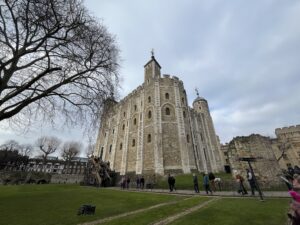London: A City with Rich History and Richer People
After spending a week in Berlin, instead of heading straight back to Bonn, I spent a long
weekend in London, where I met up with my parents. It was my first time going there, and I
wanted to make the most of my trip. I started my journey at the Churchill War Rooms, an
underground bunker that once housed Britain’s wartime operations during World War II. The
tour was broken up into two sections; there was a museum dedicated to Churchill’s life, and
there was a walkthrough of the bunker he used during the war. Walking through the bunker, we
could see all the map rooms, communications rooms, meeting rooms, and bedrooms that were
used during the war. There were cut-out sections of the ceiling that showed reinforced slabs to
protect people from bombing raids. The bunker was used from 1940 until the end of the war in
Europe. People directing the war would spend every day underground in dim lights and
conditioned air for 5 long years.
The next day of my trip, my parents and I took a boat tour down the River Thames. On the tour,
we could see a lot of historic landmarks such as the replica of Shakespeare’s Globe Theater,
the London Eye, and St. Paul’s Cathedral. We got off the boat near the Tower Bridge, one of
London’s most iconic landmarks. We crossed the bridge to get to our next destination, the Tower of London. We spent the majority of the day inside the castle walls, touring around the castle.

The first part of our tour was led by one of the Yeoman Warders, the traditional guards of the
Tower of London. The tour was informative and engaging. We learned a lot about the history of
the tower, which was once a fortress, royal palace, and prison. The tower is almost a thousand
years old, built in the 11th century by William the Conqueror. The tower was intended to be a
secure fortress to defend against invasions, but it was eventually used as a royal palace, a mint,
and a prison. Executions of prominent historical figures took place here, including two of Henry
VIII’s wives. The tower was also used to store the royal crown jewels, which we were able to
see on our tour. The tower was even used during the First World War as a prison and execution
site.
The last day of our tour was mostly spent sightseeing. We saw a few of London’s most famous
architecture such as the Parliament Building (Big Ben), Buckingham Palace, and Westminster
Abbey. At Buckingham Palace, we were able to see the changing of the guard ceremony. They
had a marching band and a parade of horses enter through the palace gates as the guards had
their lavish shift-change ceremony.
Spending a weekend in London was an unforgettable experience. From uncovering its wartime
past to marveling at royal traditions and cruising the Thames, every moment felt like stepping
into history. I would highly recommend traveling to London, even if it’s just for a short time.
There’s a lot that can be done in just 3 days.
Ben Peterson
The Tower of London: A Thousand Years of royal history, intrigue, and legends | Tower of london | historic royal palaces. (n.d.). https://www.hrp.org.uk/tower-of-london/history-and-stories/the-story-of-the-tower-of-london/
History.com Editors. (2025, February 27). Tower of London – definition, date & builder. History.com. https://www.history.com/topics/middle-ages/tower-of-london
